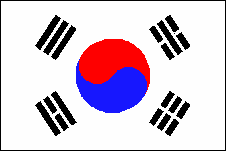|
T'aeGuk-Ki (the Korean
Flag)
 Many people have the Korean Flag
on their suits, without knowing that it has a more meaningful background than
most common flags. On this page you can find a short overview. Many people have the Korean Flag
on their suits, without knowing that it has a more meaningful background than
most common flags. On this page you can find a short overview.
Summary
The meaning of Korean
National Flag is very philosophical. The origin comes from the Oriental
philosophy called Eum-Yang, in Chinese pronunciation Yin-Yang. In Korea, the
symbol of 'Yin and Yang', and sometimes the flag itself, is called Taeguk
and summarizes the thoughts of 'I Ching' (called 'Yeok' in Korean). The name
means as much as the flag of 'Great Extremes'.
The flag consists of
three parts: The white background, the red and blue circle in the center and
four trigrams, one in each corner of the flag.
The white background of the
flag means peace.
The red and blue circle
in the center is called 'Taeguk', the origin of all things in the universe.
The central thought is perfect harmony and balance: A continuousl movement
within the sphere of infinity, resulting in one unit. The blue part of
'Taeguk' is called 'Eum' and represents all negative aspects of the balance
that is typical for the symbol. The red part is called 'Yang' and describes
all positive apects.
The four trigrams at the
corners (called 'Kwe' in Korean) also represent the concept of opposites and
balance. The trigrams are heaven (upper-left) and at the other corner earth,
water (upper-right) and at the other corner fire. Looking at symbols of the
trigrams, you can see that they are opposites as well. Three unbroken bars
(heaven) vs. three broken bars (earth), etc.
For the Korean people
their flag of T'aeGuk-Ki is a source of pride and inspiration. During the
Japanese occupation period beginning in 1910 the Korean flag was outlawed in
public places and for about thirty five years the T'aeGuk flags were kept
hidden until Liberation Day in1945. The Korean flag has been a symbol of this
country's struggle for independence and freedom.
Origin
![[taegok]](simbolos%20taekwondo_archivos\taegeok.jpg) The oldest 'Yin/Yang'-symbol, which was described in stone, was found
in Korea. At the end of the 19th century, Korea needed their own flag. It is
believed that Young-Hyo Park came up with the first concept. At that time,
Korea was under the influence of all sorts of colonists like the Japanese,
Chinese and Russian. The oldest 'Yin/Yang'-symbol, which was described in stone, was found
in Korea. At the end of the 19th century, Korea needed their own flag. It is
believed that Young-Hyo Park came up with the first concept. At that time,
Korea was under the influence of all sorts of colonists like the Japanese,
Chinese and Russian.
The symbols
![[yin-yang]](simbolos%20taekwondo_archivos\yy.gif) Yin means dark and cold, while Yang means bright and hot. A very old
book called Choo-Yuk which is written by a Chinese claims all objects and
events in the world are expressed by the movement of Yin and Yang. For
example, the moon is Yin while the sun is Yang. The earth is Yin and the sky
is Yang. The night is Yin and the day is Yang. The winter is Yin and the
summer is Yang. Yin and Yang are relative. Therefore, A can be Yin with
respect to B while A can be Yang with respect to C. For example, the spring
is Yin w.r.t. the summer and it is at the same time Yang w.r.t. the winter. Yin means dark and cold, while Yang means bright and hot. A very old
book called Choo-Yuk which is written by a Chinese claims all objects and
events in the world are expressed by the movement of Yin and Yang. For
example, the moon is Yin while the sun is Yang. The earth is Yin and the sky
is Yang. The night is Yin and the day is Yang. The winter is Yin and the
summer is Yang. Yin and Yang are relative. Therefore, A can be Yin with
respect to B while A can be Yang with respect to C. For example, the spring
is Yin w.r.t. the summer and it is at the same time Yang w.r.t. the winter.
|
![[heaven]](simbolos%20taekwondo_archivos\heaven.gif)
|
Kun
|
Heaven
|
|
![[fire]](simbolos%20taekwondo_archivos\fire.gif)
|
Yi
|
Fire
|
|
![[water]](simbolos%20taekwondo_archivos\water.gif)
|
Kam
|
Water
|
|
![[earth]](simbolos%20taekwondo_archivos\earth.gif)
|
Kon
|
Earth
|
Parts of this text were
contributed by Byung-Gyo Suh
Question
Question from Kenneth
Bomholdt Bro Nielsen:
I have a question
about you page concerning patterns. You show a picture of the pal-gwe, which
represent the eight tae- guk?s, and the unity of yin and yang. If you take
the tae-guk Il Jang, which represents the South, Father (the tree unbroken
lines), then it is placed at the north position on the picture of the
pal-gwe. Shouldn?t the picture bee rotated so Il Jang is located at the
bottom of the picture (to the south)?
Answer
Reply from Byung-Gyo
Suh
What I guess is that top of the flag may not mean the north. The Yang part of
TaeKuk, i.e. the red half-circle, is positioned on top of Yin, i.e. the blue
half-circle. In other words, the north (Yin, Blue) and south (Yang, Red)
seems to be up-side-down, but it's not up side down; Yang is supposed to be
above Yin. For example, sky (Yang) is above the earth (Yin).
Another explanation might
be the following...
Traditionally, a king or a god was supposed to sit facing the south. So, when
you are talking about "left" it really means the east while the
west is on your "right" hand side. Applying the same logic to
TaeKukKi, top (Red) of the flag stands for the south.
|